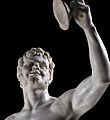Rondanini Faun facts for kids
Quick facts for kids Rondanini Faun |
|
|---|---|
 |
|
| Artist | François Duquesnoy |
| Year | 1620s |
| Type | Sculpture |
| Medium | Marble |
| Subject | A faun |
| Dimensions | 175 cm (70 in) |
| Location | British Museum, London |
| 51°31′10″N 0°07′37″W / 51.5195°N 0.1269°W | |
The Rondanini Faun is a cool marble statue made by a Flemish artist named François Duquesnoy. You can find it today at the British Museum in London. This statue is special because it was built using an old, broken statue part, which Duquesnoy finished between 1625 and 1630. People in Rome at the time thought his work was "absolutely perfect"!
In the 1600s, it was common for artists to fix old Roman statues. They often added new parts in the popular style of their time, called Baroque. The Rondanini Faun shows some of this lively Baroque style. Duquesnoy made the arms, legs, and head for this statue. He also added a faun tail to what was once just a broken body. The statue gets its name from the Palazzo Rondanini in Rome, where it used to be kept.
About the Rondanini Faun
This famous statue is known for its lively look. It shows a faun, which is a mythical creature, in the middle of an action. The faun is standing on the toes of one foot, with the other foot lifted. Both of its arms are stretched out, and its head is raised. It looks like the faun has just jumped and is about to hit the cymbals it holds.
How the Statue Was Made
The artist, François Duquesnoy, was known for his amazing skill in finishing old statues. He took an ancient marble torso (the body part of a statue) and added new pieces to it. He created the head, arms, and legs. He also added a faun tail to the original broken body.
Experts like Giovanni Pietro Bellori, who wrote about Duquesnoy's life, and Duquesnoy's own student, Orfeo Boselli, agreed that Duquesnoy finished this statue. Boselli even wrote about the Rondanini Faun as an example of Duquesnoy's great talent. The way the faun's arms are posed helps to show its broad, active movement.
Duquesnoy completed this artwork for a person named Alessandro Rondanini. That's why the statue is named after the Palazzo Rondanini in Rome, which was Alessandro's palace.
Images for kids


